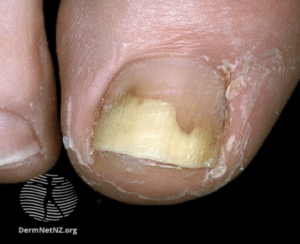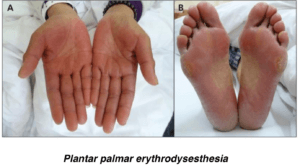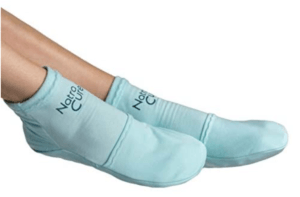How can podiatrists help with hand-foot syndromes?
Welcome to this article about ‘hand-foot syndromes’
Hand-foot or palmar-plantar syndrome (HFS) and hand-foot skin reactions (HFSR) arise with cancer therapy. Initial symptoms include; swelling, numbness, a sense of tightness/stiffness due to the swelling), and pain in the palms and/or soles. This is followed 2-4 days later by bright well defined, redness that features on both sets of palms and soles accompanied by swelling (oedema). Some patients may see nail changes such as nail separation (onycholysis) and ingrown toenails.

Toe nail onycholysis is common after cancer care but it is not a sign of cancer only an effect from treatment. C/O DermNetNZ.org

Plantar palmar erythrodysesthesia (image C/O BCCcancer.bc).
Medication causing the problem
Prescriptions of certain chemotherapy drugs such as Capecitabine cause both skin and nails to be affected where the skin heals without scarring. With each subsequent cycle of chemotherapy the reaction will appear more quickly, more severely and can take longer to heal due to the patient’s compromised immunity. As the skin is painful to touch, pain medication may be recommended prior to treatment. Patients with Asian-Indian origins tend to be affected by blistering and ulcerations on the heels and lateral borders of the soles, and their skin becomes thin and shiny with deep open fissures.Hand foot skin reactions arise in areas of friction or pressure in the soles and palms within the first few weeks of anticancer treatment. This may be due to increased leakage of the anticancer therapy through mechanical trauma of the skin.
The patient’s palms and soles appear to have been stained in red paint. The redness doesn’t appear as vibrant in Afro-Caribbean and Asian skin but it is still noticeable. Intervention aims to prevent skin problems such as painful blistering, shedding skin cells, crust formation and ulceration (deep splits in the skin). The skin reactions can appear as painful blisters and develop into thickened skin layers (hyperkeratosis). Taking weight on the sensitive foot can cause falls as part of hand-foot syndrome disablement as the patient tried to alter their foot base avoiding pressure.
Management of these two conditions is challenging and relies on the right intervention at the right time. Accounting for the patient’s lifestyle must be considered and how best to support them in maintaining key elements of their daily activities, recognising that they are already having to manage a large amount of disruption to their normal routines whilst undergoing treatment. HFS and HFSR can be particularly problematic for those patients with active lifestyles involving standing.
Common chemotherapy drugs affecting feet
- Anthracycline antibiotics
- Cytarabine
- Docetaxel
- Capectabine (or 5-fluoroucil)
- Doxorubicin
Self care advice

Reducing skin temperatures
Keeping feet cool has been found to help reduce swelling and stiffness occurring in the foot. This can minimise the chances of any agent leaking through the vessels as the foot stays cooler for longer and reduces the amount expelled out through sweat glands. The use of frozen socks to prevent docetaxel-induced onycholysis and cutaneous toxicity of the foot. Cooling hands and feet might prevent reactions of HFS for patients receiving paclitaxel, docetaxel and doxorubicin.

NatraCure is an example of one design of ‘cool sock’. A gusset allows a cooling pack to slide over the foot. This is only one type of product and used in the article as an illustration only.
Special materials
At our clinic Tiptoe Foot Care we provided patients with instructions on how to use a special gel socks to help reduce symptoms significantly, particularly during and after chemotherapy administration. Patients have exhibited improved healing times and better skin quality. The mineral oil impregnated in the socks (not shown) also improves the moisture content of the skin, preventing Xerosis (dry skin) and blistering, potentially making this a more effective solution than frozen socks.
The second key to self-care found helpful is to soothe skin irritation and sores by bathing the feet in a warm salt water solution containing a mixture of Epsom salt and normal table salt for 5 minutes
Good hygiene
Maintaining good hygiene is important in reducing the risks of infection, and the magnesium in the Epsom salts helps reduce inflammation and aids healing of the skin. Salt (sodium chloride) helps cleanse the skin gently and reduce infection from the onycholytic nails. It is also important during this time to see a podiatrist to monitor the effects of HSF as a podiatrist can quickly help reduce complications occurring from these drugs and give advice.
Please read other articles by Afni Shah-Hamilton
Topical articles:
Cancer and the foot
Five Conditions in feet caused by medication to treat cancers
Supplementary facts and podiatry from Afni Shah-Hamilton
How can podiatry help with peripheral neuropathy?
How can podiatrists help with the toxic effect of medication on nails?
How can podiatrists help with Xerosis?
Thanks for reading ‘How can podiatrists help with hand-foot syndromes?by Afni Shah-Hamilton
published by Busypencilcase Communications![]()
for

April 2020. Modified March 2021

Recent Comments